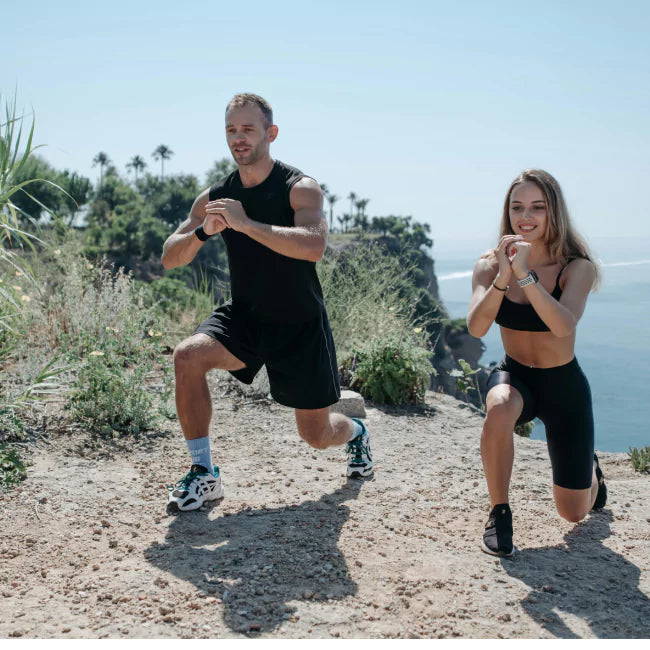What’s with Wearable Fitness Technology?
 By: by Amino Science
By: by Amino Science

Wearable fitness devices have become all the rage. Just scope out all the gym rats glancing down at their wrists between sets! You've probably seen people wearing fancy watches that can track heart rate and fitness activities, but just what exactly is wearable fitness technology?
The craze began with basic wearables like pedometers, heart rate monitors, and calorie counters, and has morphed into more sophisticated devices that can track all your fitness data. Wearable fitness devices track your heart rate, the distance you travel, how many calories you burn, and how much exercise you do each day. Set your fitness and health goals, and your fitness tracker will alert you when you've reached them. Some of these devices can connect to apps on your smartphone to measure your long-term progress and share your data with fitness groups.
Best Fitness Trackers
![]()
Fitbit
With the promise of multi-day battery life, Fitbit has a variety of activity trackers to suit your needs and budget. No matter which model you choose, you're covered with distance, calorie burn, and step counting, while more sophisticated models also offer heart and sleep monitoring.
An upgrade from the Fitbit Charge 2, the Fitbit Charge 3 features a streamlined design and the smartwatch features you depend on. Lightweight with a grayscale touchscreen display, the Charge 3 monitors heart rate and daily steps, and jumps on board automatically to track workouts and even menstrual cycles for women if you wish. You can also take texts and calls and check your social media accounts on this handy wearable device.
Or you can get fit with the more top-of-the-line Fitbit Ionic or Fitbit Versa fitness trackers. They've got more app compatibility, better visuals on the screen, and built-in GPS. If you're willing to splurge, then the Ionic or Versa are sweet upgrades.
Garmin
A smart option for runners and outdoorsy types, the Garmin Vivosport is lightweight with an integrated GPS and heart rate monitor. This water-resistant tracker does everything from sleep tracking to workout tracking. It helps you measure your fitness goals with personal records and a virtual pacer, and you can sync up with the Garmin Connect app to track your metrics over time.
Want a slimmer, sleeker, slightly cheaper Garmin option? You could opt for the Vivosmart 4, which is a lighterweight choice that also comes equipped with a Body Battery Energy Monitor so you know when to go hard and when to back off, as well as a function that measures your oxygen saturation levels. Still, you won't get the GPS integration function with the Garmin Vivosmart and may miss the better lit display of the Vivosport.
And then there's the least expensive option, the Garmin Vivofit, which is a slim-fitting fitness tracker that tracks the basics—steps, distance, calories, sleep—but doesn't have all the smart functions you may desire.
Apple Watch Series 4
Leave it to Apple to make its mark on the fitness industry. The Apple Watch is for iOS users looking for the best of the best in fitness trackers. It's compatible with most third-party fitness apps, boasts GPS tracking, changes in altitude, onboard heart rate monitoring, and even an electrocardiogram app certified by the FDA. Your Apple Watch comes complete with Bluetooth and Siri, all in typical Apple style.
Samsung Gear Fit2 Pro
Android users can get onboard the fitness tracker train with the Samsung Gear Fit2Pro, complete with GPS technology and smartwatch bells and whistles. It has an ultra-detailed display, it monitors your heart rate, and it tracks your fitness data. Samsung has designed a fitness tracker with a minimalist look that stores and streams music, tracks typical fitness metrics, is water resistant, and features a top-notch display. And yes, you can still get social and take phone calls and texts.
Withings Steel HR Sport
Withings emerged onto the wearable tech market in 2015 with its Activité Pop smartwatch, and it's holding strong among the best wearable fitness tech companies in 2019 with its newly released Steel HR Sport. This hybrid watch is stylish, with a traditional analog face and integrated smartwatch features, GPS connectivity, and activity tracking. It measures your steps in percentages, monitors your sleep, and tracks your heart rate and VO2 max so you know how much oxygen you're using when exercising. If you're looking for subtlety with all the digital dressings, the Steel HR Sport might be your favorite.
Moov Now
Perhaps the best wearable fitness tracker for those on the budget, the Moov Now is noted for its outstanding 6-month battery life, and while it doesn't have the fancy trappings of many of the other fitness trackers on this list, it will keep track of your steps, your boxing and rep-based activities, and even monitor your swimming and running goals as well as your sleep.
Polar Loop
An "activity band with smart guidance" this wearable fitness tracker offers the same functions as the others, tracking sleep, calories, and steps. Sync it up with your smartphone to account for goal setting and reminders, and enjoy the personalized guidance and motivation throughout your day. Rest easy knowing its waterproof and durable.
Smartwatch
Skagen created the Signatur Connected Hybrid Smartwatch, a classier option compared to a standard smartwatch. The company specializes in elegant, smart devices that do not look like wearable tech. This watch tracks activities, and it synchronizes with your smartphone. This is an excellent choice if you are looking for a more sophisticated wearable.
Smart Shoes
This option is considered “invisible” wearable tech. Under Armour, for example, has integrated a fitness tracker right into the soles of the shoes, so you do not need to wear a smartwatch to record your fitness data. These smart shoes have an accelerometer that records running metrics, as well as Bluetooth, and keeps all metrics logged in an app.
Science and Benefits
The National Institutes of Health says that if you walk fewer than 5,000 steps per day, you have a sedentary lifestyle—if you take more than 10,000 steps per day you are considered “active.”
With reminders and accountability tools, wearable fitness trackers can help people get more active. Using a smartwatch can also reduce the strain of upper vertebrae, known as “text neck” and cervicalgia, because wearers raise their arms to look at wrist-worn displays instead of lowering their heads to look at the phone.
Another benefit of wearable technology is that it helps you engage with your surroundings. “What we’re really trying to achieve is the idea of freedom from your phone,” says David Ng, a wearable product manager for Samsung. Trackers that monitor your heart rate are also great because they can keep track of your resting heart rate—a key value when it comes to hypertension and heart disease.
Science, however, has not been so in awe of wearable fitness technology.
Research published by the Lancet Diabetes & Endocrinology found that activity trackers had no effect on health and fitness. The results of another study conducted by the University of Pittsburgh and published in the Journal of the American Medical Association showed that subjects who didn't use fitness trackers lost more weight than the group that used wearable fitness technologies.
When considering the less-than-stellar findings, it’s important to note that most existing studies, including the two mentioned above, used devices that are several years old—outside experts agree that fitness tech is improving.
“There are two things, specifically, that apps and devices are actually getting better at,” said Mitesh Patel, a researcher at the University of Pennsylvania. In his opinion, the first is leveraging social networks to foster competition and support. A study, conducted by Liza Rovniak, a Penn State psychologist, showed that support networks are effective at increasing physical activity in unmotivated adults. The second factor devices are improving, according to Patel, is goal setting. He sustains that the problem with early fitness trackers was that they all used the same goal (step count) and they all set the bar way too high. Today’s fitness wearables tailor their feedback to users’ individual habits, instead of telling you to take 10,000 steps.
Of course, there will always be people who prefer to track their own progress and go to the doctor to measure heart rate. But wearable tech is an excellent option to consider if you want to develop a new relationship with your fitness routine, but you can also decide to keep on working out the traditional way, without any wearable fitness technologies—the important thing is that you find time to exercise!
You can go even further and log more steps into your fitness tracker with the support of an essential amino acid supplement designed to improve muscle performance during exercise, enhance mental clarity and concentration, reduce fatigue and dehydration, and minimize recovery times. Learn more here.

Up to 25% off Amino
Shop NowTAGS: cardiovascular
Join the Community
Comments (0)
Most Craveable Recipes




 833-264-6620
833-264-6620



















